In my last blog I introduced one type of calling station known as a “stabber.” Stabbers are still common and low-hanging fruit in poker. They like to be aggressive, which is the right frame of mind. But they are ham-handed about it.
What stabbers do is call you in position preflop at a higher-than-optimal frequency. If you continuation bet the flop they call, hoping that you are bluffing. Then when you check the turn, they stab at the pot to steal it from you.

Stabbers use their positional advantage. If you check the flop or turn, they see it as weakness and attack it. They see themselves as a shark that smells blood in the water.

Because the stabber bluffs too often in those spots, you can exploit him with the check-raise. Stabbers can be very profitable for you. But don’t overdo it. You want to avoid shutting down the stabber. You also want to avoid having him raise back at your check-raise because he figured out what you’re doing.
Here is an example of a calling range in the cutoff against a middle position open that is pretty close to optimal. I generated these images using the GTO+ solver. Disregard the colors in this image as they simply denote the combo type:
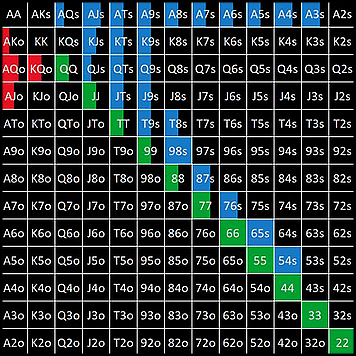
Let’s say we get a static flop of A♥ 7♣ 2♠. You as the middle position opener can check your range, except for an extremely polarized and small betting range. A nearly optimal player in the cutoff has the following range facing a check, checking back 85% of the time. Green is check back, and blue is bet:
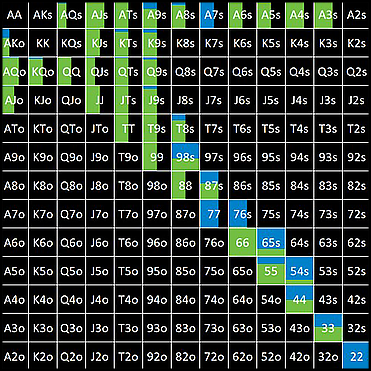
Here is an example of the stabber’s preflop calling range in the same scenario. You can see that the stabber calls with many unprofitable combos:
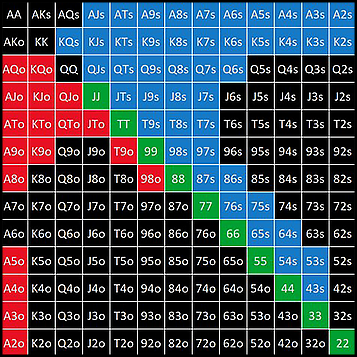
Static Flop
After the open raiser in middle position exploitatively checks his entire range on the flop of A♥ 7♣ 2♠, the stabber bets half pot with his entire range. Here is the maximally exploitative response for us, generated by the GTO+ solver:
Middle position is check-raising the stabber with 60% of his range! He is calling with another 28% of his range. He only folds 12% of the time.
With the pot on the flop at 8bb, stabber bet 4bb with his entire range after middle position checked. Then with the pot at 12bb with action of 4bb, the middle position player raised to 16bb 30% of the time and raised to 8bb 30% of the time.
The big raises are with the most polarized range, minus top set (the nuts). The smaller raises are with good value hands balanced with some bluffs. The calls are with hands that have some showdown value but would hate to see a raise.
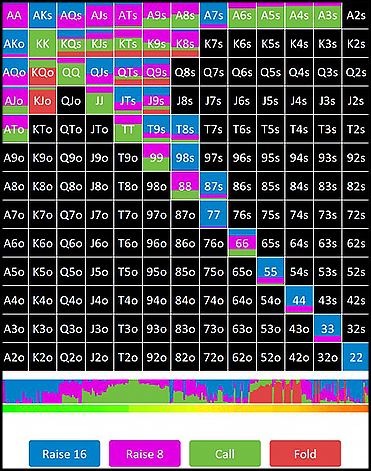
Keep in mind that your stabber will tend to give up on most gutshot and backdoor flush draws against the big check-raise size, but will tend to hang in there more often with these draws against the smaller check-raise size.
You could start out with a strategy like this, but after a time you may have to moderate this strategy to keep the profits flowing.
Dynamic Flop
Let’s change things up a bit and examine a dynamic flop that is more favorable to the stabber’s range. I kept the preflop ranges for the middle position opener and the cutoff stabber the same as given above.
On a flop of 9♥ 7♥ 5♣ the stabber actually has the nut advantage. 86 is the nuts and the stabber has four combos of the suited variety of 86. The stabber also has many good draws.
The middle position player checks and the stabber stabs with his entire range, as in the previous example. Here is the middle position player’s defending range:
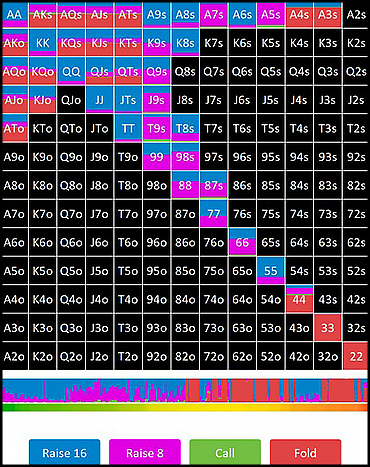
The middle position player now check-raises 66% of the time and never calls. Of the check-raises, nearly two-thirds use the larger sizing. When exploiting a stabber on a wet, dynamic flop like 9♥ 7♥ 5♣, charge him an expensive price on his straight and flush draws when you have sets and overpairs.
Use the smaller raise size when you could have the stabber drawing dead on flush draws and straight draws, as well as lower pairs that might like to see folds but still have some showdown value against missed draws and lower pairs.
Above all, don’t give away a free card by calling his stab bet on these wet, dynamic flops.
Conclusion
As you can see, stabbers are very exploitable with the check-raise. They call preflop with too many hands and then bluff too much when the preflop raiser checks to them.
But avoid teaching your stabber how to play better poker. Make continuation bets out of position at times instead of always setting him up with range checking on the flop. Fold extra combos on the flop when you’ve already check-raised him two or three times in a row.
Remember, you can shear a sheep a hundred times but only skin him once.
Best of luck to you, and go get those stabbers!

